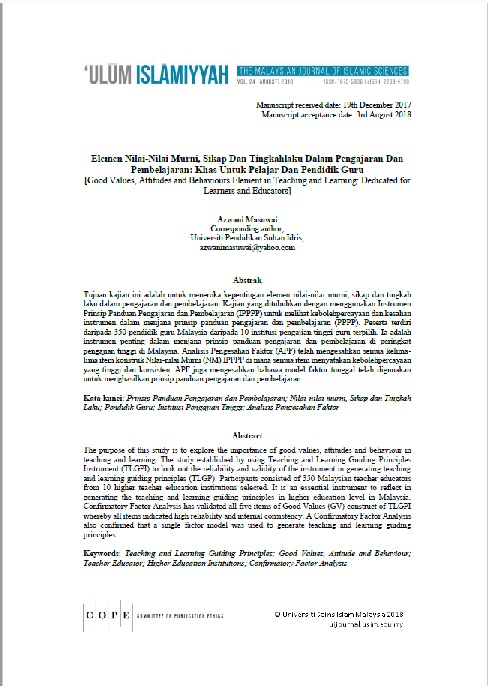Elemen Nilai-Nilai Murni, Sikap Dan Tingkahlaku Dalam Pengajaran Dan Pembelajaran: Khas Untuk Pelajar Dan Pendidik Guru
[Good Values, Attitudes and Behaviours Element in Teaching and Learning: Dedicated for Learners and Educators]
DOI:
https://doi.org/10.33102/uij.vol24no0.62Keywords:
Teaching and Learning, Guiding Principles, Good Values, Attitude and Behaviour, Confirmatory Factor Analysis, Higher Education InstitutionsAbstract
The purpose of this study is to explore the importance of good values, attitudes and behaviour in teaching and learning. The study established by using Teaching and Learning Guiding Principles Instrument (TLGPI) to look out the reliability and validity of the instrument in generating teaching and learning guiding principles (TLGP). Participants consisted of 350 Malaysian teacher educators from 10 higher teacher education institutions selected. It is an essential instrument to reflect in generating the teaching and learning guiding principles in higher education level in Malaysia. Confirmatory Factor Analysis has validated all five items of Good Values (GV) construct of TLGPI whereby all items indicated high reliability and internal consistency. A Confirmatory Factor Analysis also confirmed that a single factor model was used to generate teaching and learning guiding principles.
Abstrak
Tujuan kajian ini adalah untuk meneroka kepentingan elemen nilai-nilai murni, sikap dan tingkah laku dalam pengajaran dan pembelajaran. Kajian yang ditubuhkan dengan menggunakan Instrumen Prinsip Panduan Pengajaran dan Pembelajaran (IPPPP) untuk melihat kebolehpercayaan dan kesahan instrumen dalam menjana prinsip panduan pengajaran dan pembelajaran (PPPP). Peserta terdiri daripada 350 pendidik guru Malaysia daripada 10 institusi pengajian tinggi guru terpilih. Ia adalah instrumen penting dalam menjana prinsip panduan pengajaran dan pembelajaran di peringkat pengajian tinggi di Malaysia. Analisis Pengesahan Faktor (APF) telah mengesahkan semua kelima-lima item konstruk Nilai-nilai Murni (NM) IPPPP di mana semua item menyatakan kebolehpercayaan yang tinggi dan konsisten. APF juga mengesahkan bahawa model faktor tunggal telah digunakan untuk menghasilkan prinsip panduan pengajaran dan pembelajaran.
Downloads
References
Byrne, B.M. (2001). Structural Equation Modeling with AMOS, EQS, and LISREL: Comparative approaches to testing for the factorial validity of a measuring instrument. International Journal of Testing, 1(1): 55–86.
Eberly Centre - Carnegie Mellon University. Principles of teaching. Retrieved from https://www.cmu.edu/teaching/principles/teaching.html.
Griffith University. Principles to promote excellence in learning and teaching practices at Griffith University. Retrieved from http:// www.griffith.edu.au/__data/assets/pdf_file/0006/.../PrinciplesLandT.pdf.
Hair J. F., Anderson R. E., Tatham R. L., Black W. C. (2010). Multivariate Data Analysis. Seventh Edition. New Jersey: Prentice Hall.
Kanuka, H. (2002). Guiding principles for facilitating higher levels of web-based distance teaching and learning in post-secondary settings. Distance Education, 23(2): 163-182.
Masuwai A., Tajudin N. M., Saad N. S. (2016). Evaluating the face and content validity of a Teaching and Learning Guiding Principles Instrument (TLGPI): A Perspective Study of Malaysian Teacher Educators. Malaysian Journal Society and Space. 12(3): 11-21.
Schumacker, R.E., & Lomax, R.G., 2010, A Beginner’s Guide to Structural Equation Modeling (3rd Ed.). New York: Routledge, Taylor & Francis Group.
Tajudin, N., Rahman, N. A., Masuwai, A., & Idris, N. (2014). Comparison between Teaching Practices Based on Teacher Educators' Perception and Learning Experiences Based on Student Teachers' Perception at Higher Education Institution. Research Journal in Organizational Psychology and Educational Studies (RJOPES), 3(6): 437-445.
University Education Research Laboratory. (2014). Development of a teacher education model for preparing quality teachers for the future (2014 – 2018) 2nd Edition. Unpublished manuscript, Universiti Pendidikan Sultan Idris, Tanjong Malim, Perak.
University of Hong Kong. Educational aims. Retrieved from http:// www.als.hku.hk/admission/file/prospectus/286/3yrs.pdf.
University of Melbourne. (2007). Nine principles guiding teaching and learning. Retrieved from http://www.cshe.unimelb.edu.au/resources_teach/framework_teach/docs/9principles.pdf.
The University of Nottingham. Organisation of teaching. Retrieved from http://www.nottingham.ac.uk/.../universityofnottinghamstrategicplan2010-15.
Wang, C. L., & Ahmed, P. K. (2004). The development and validation of the organisational innovativeness construct using confirmatory factor analysis. European journal of innovation management, 7(4): 303-313.
Wichita State University. Teacher Education Student Handbook. Retrieved from http://webs.wichita.edu/depttools/depttoolsmemberfiles/COEdESS/Handbooks/TeacherEd_handbook.pdf.

Downloads
Published
How to Cite
Issue
Section
License
If the article is accepted for publication, the copyright of this article will be vested to author(s) and granted the journal right of first publication with the work simultaneously licensed under the Creative Commons Attribution-NonCommercial 4.0 International License, unless otherwise stated. Anyone may reproduce, distribute, translate and create derivative works of this article (for both commercial and non-commercial purposes), subject to full attribution to the original publication and authors. The full terms of this licence may be seen at https://creativecommons.org/licenses/by-nc/4.0/.






